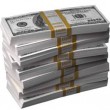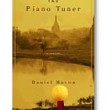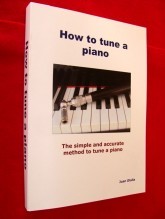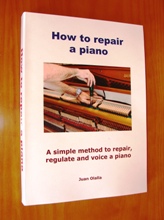Please, write here any particular comment and/or question you might have. Thanks
Learn to tune pianos
Recent articles
- Buying a second hand piano – practical guide
- Piano tuning procedure
- Sharp and loud piano… learn how to get a mellow and smooth sound
- How much money can make a piano tuner, is it profitable?
- Digital piano or acoustic piano
- Fast piano tuning, the tricks of the pros
- My eBooks to tune and repair pianos
- About How to tune a piano eBook
- About How to repair a piano eBook
- Five powerful reasons why you should also learn to tune your own piano
- Aural piano tuning versus electronic piano tuning
- Old pianos, the plain truth
- Why some pianos don’t stay in tune
- Tuning a piano with an electronic tuner
- Tuning a piano in noisy environments, tricks from the pro
- “The piano tuner” by Daniel Mason (reviewed by another piano tuner)
More Feature posts

How much money can make a piano tuner, is it profitable?
Is it profitable to tune pianos? A few days ago, looking the statistics at the control panel of this site, I saw an interesting phrase by which somebody found us in the Google search engine. This was the phrase: Is it profitable to be a piano … [Read More...]

Tuning a piano with an electronic tuner
This free guide will show you how to “really” tune a piano with an inexpensive tuner. If you want to tune your own piano and have a decent chromatic tuner, this articule is for you. Reality check: Most piano tuning tutorials you see on … [Read More...]

Tuning a piano in noisy environments, tricks from the pro
They called you to tune a piano for a concert at the last hour. The time available is ridiculously short, about half an hour, and to top it up is very noisy. What to do? This is one of the tricky situations a piano tuner might encounter, when … [Read More...]

“The piano tuner” by Daniel Mason (reviewed by another piano tuner)
I don’t consider myself a compulsive reader but every now and then I find the time to relax and read, even if it is only for a few minutes. Sometime ago while visiting a book-shop at my home town I found a book that catch my eye “The piano … [Read More...]
How to tune a piano & How to repair a piano – ebook download
The e-books are well organized and complete. Although I am not a professional musician, I learned a lot about the art of piano tuning and piano mechanics. I have a much better appreciation for what is going on "under the hood" to make those piano strings resonate harmoniously. The engineer in me would have just wanted to tune each string to its standard theoretical frequency. Now I understand why that is not a good idea and why using your ears is so important to the process. The books are user friendly with recorded sound examples to guide the reader, and the explanations are clear even if English is not the author's first language.
Andrew Walker, Acton Massachusetts, USA
Dear Juan,
I found your book excellent, It is very comprehensive and covers all that a beginner would need to know. Overall it is beautifully presented and I find no fault with it at all. The photographs are very clear and are more than useful to the explanations in the text. It makes me feel confident to have a go myself.
Tom Robinson (England)
Hi Juan,
I have read your book and I think it’s very well written in that it is comprehensive with the right amount of detail and helpful diagrams. For those who want to learn to tune and repair pianos, your book will be very useful.
Howard Lock (UK)
| M | T | W | T | F | S | S |
|---|---|---|---|---|---|---|
| 1 | 2 | 3 | 4 | 5 | 6 | 7 |
| 8 | 9 | 10 | 11 | 12 | 13 | 14 |
| 15 | 16 | 17 | 18 | 19 | 20 | 21 |
| 22 | 23 | 24 | 25 | 26 | 27 | 28 |
| 29 | 30 | 31 | ||||
Copyright © 2025 Juan Olalla · · Log in



Hi Juan! My piano is some 20 y.o. and I’ve had two tuners work on it previously. Both of them told me that the piano is a half step lower than it should be, but this is how it was built and they cannot do anything about it. Is there anything to be done about it, just that it would take a lot more time to tune it properly? Maybe if I would assure the tuner that he will be paid by the hour, just so that he gets the job done, he would be willing to do it … Thank you!
Hi Juan,
I wish to get more information about muy piano KAPS P. VAN LEEUWEN & Zn Amsterdam and this 2 Numbers 6330 and 263 and price.
Many thanks!
Toñi
Hi Toñi,
Sorry, I do not have any reference about your piano. I think it could be what they call a “stencil piano”, that is a piano built by large factory and labeled with a manufacturer’s name not related to the factory. Very often they use the name of a well known piano or music store.
Regards,
Juan
Hi,
I recently bought a home with a beautiful piano just abandoned there, so unloved. It is a Hardman &Peck baby grand with serial number 110010. It was very loved at one point because the condition is superb. However, I believe it is out of tune. Do you have any information on this piano? Unfortunately, the house was bought as a rental so I need to find out if it is worth moving to my primary home or if I should sell it and put the money into a new piano fund. Thanks so much in advance.
Kathleen
Hi Katheleen,
Your piano was made in 1956 in New York. If the piano is well looked after and is in a good condition it looks like a nice present, I wish I had your good luck! If it is out of tune, contact a technician to tune it, but if it has been too long without tuning it might need a secondary tuning and some regulation. Best thing is to call a pro piano tuner to give you an estimate.
Regards,
Juanb
Hi Christian,
You don’t see many pianos these days for 15 bucks!! That piano was built in the year 1908. If you want to clean the ivories just try lemon juice or hydrogen peroxide (can buy in pharmacies) diluted in water, sometimes it works sometimes it doesn’t, depended of the ivory types. If cleaning is not possible you can buy a set of ivory keys from http://howardpianoindustries.com/. Good luck with the piano.
Regards,
Juan
Hello Ed,
In ebay you can buy excellent quality piano wire at http://stores.ebay.com/Howard-Piano-Industries?_trksid=p2047675.l2563. Also very good price.
Regards,
Juan
I have a question about my upright piano. its quite old, i took it apart as by that i mean i took the Hammer rail system completely out and when i put it back in, suddenly some of the hammers seem to be stuck against the strings without the key even being pressed, this makes it impossible to press down the key and is annoying the crap out of me and i would really like to know how to fix it myself, somebody please help.
Hi Paul,
I guess what you mean is that you removed the action from the piano and could not place it back properly in place. It looks like you did not set the action properly into their bolts. Try again to remove it and then carefully put it back. If it does not work you can send us some pictures and will try to help you. Regards, Juan
Hello Edwin,
The best advice I can give you to set the pins is to strike the keys with firm blows. An extendable tuning lever is always better than a non extendable one, also makes tuning easier, specially for beginners. You can buy a decent tuning lever for around 90 USD. Google a little bit and you will find quite a few online stores you can buy from.
Regards,
Juan
Hi John,
Fiddling with strings like that it is much more difficult that replacing them for new ones. In ebay you can find cheap piano wire for the different sections of your piano.
Regards,
Juan
Hi Angie,
According to the serial number, your Mendelssohn piano was built in NY in 1902. Problem with pianos that old is that they are very expensive to renovate them, in general it´s dearer than buying a new one. You should call a piano tuner to see the piano and give you some advice. I would love to service the piano for you, but it could be a bit dear by way of travelling expenses (just right now I live in Spain) so better to look for a piano technician near your area, there many good ones in Canada.
Regards,
Juan
I have a Kaps 6 foot grand piano serial number 7265. The patent is from 1878 Dresden. It has been repaired but not particularly well. Sound board and pin board are fine. It holds tune better and better with each tuning (3 so far in the past year). Can you tell me what year this piano was made and what the general opinion is of this make and model? I have a professional in to tune once a year but it does have some issues in between and I would like to start tuning it in between the professional tunings (do you think this is wise?). Thanks for you advice and opinions.
Best,
Ravil
Hi Ravil,
No wonder you have some issues in between tunings, your Ernst Kaps piano was build in 1882!! It is not a well known piano, production was discontinued by 1930, so you do not see many of those Kaps around. Yes it is wise to tune the piano yourself in between pro tunings, that is what many people already does. You do not have to be a proficient tuner to better your piano, and it is amazing what a few “little touches” like adjusting unisons and octaves (within the reach of practically everybody) can do for your piano. These techniques surely you can learn, we’ll be happy to help.
Best wishes for the new year,
Juan
Hi Juan,
Thanks for all the great information. I have a question. I have a brand new (4 years old) Yamaha Grand and I am going to attempt to tune. I have tuned before a few notes on several pianos and being a musician for all my life, I know and can tell the beats and interval and unison tuning you talk about.
My question id when I just checked the A above middle C, it is flat -20 cents on my Korg OT-120. It seems like all the notes are flat -20 cents. Do you recommend I bring the temperament up 20 cents to be dead center in tune? Is this to much of a raise in pitch to cause problems and break a string(s)?
I greatly appreciate your reply.
Thanks,
Ray
Hi Ray,
20 cents down in pitch is not too flat, in fact it is quite ordinary. 20 cents is the equivalent to 5 beats (4 cents = 1 beat), that means your piano it is roughly at 435 bps.
Yamaha grands are in general pianos easy to tuned, beats are easy to hear and recognize. To do a good job I recommend you tune the piano in two times. First time bring the piano to standard pitch 440 bps (at this stage do not need to be too precise) and let the piano settle down for one or two days, then fine tune again, this second time try to be as precise as possible with special attention to the unisons. I think by following this procedure, your piano will nicely tuned. Remember to strike the keys solidly (very important) in order to settle down the pins. Good luck!
Regards,
Juan
Thank you Juan.
I will give that approach a try and tune two times. I appreciate the great information you provide on your blog.
Ray
Hi Cabbie,
Thank you for visiting our web. Your piano was built at Derby, Connecticut in 1917. By no means it has to be a lost caused, I have seen pianos much older than that and still in good condition. If it has not been tuned for a long time, it would probably needs to lift the pitch to standard A440 and also a good regulation. Those two things do not have to be necessarily expensive and will make wonders for the piano.
Probably your best option is to call a good piano tuner to give you an estimate and his/her professional advice.
Regards,
Juan
Hello Andre,
Because you gave us three different numbers, I can not really guess which one is the good one. Any way, the number 18145 points out that the piano was made around 1836, the number 8479 that the piano was made around 1826 and the number G27897 that the piano was made around 1840. Not too much difference, really.
Collard&Collard is one of the oldest and most prestigious piano companies in Great Britain. These pianos were made in London. In 1929 Chappell acquired the company but the production discontinued by 1960. I have seeing a few of these pianos and they can be considered “collectors items”, full of charm and character. The down point is that to restore a piano so old appropiately can be very costly, more than buying a new piano.
Regards,
Juan
Hello Hamed,
Thank you for reading my blog and sorry for the delay in answering your comment. Ok, about the ET (I guess you are talking about “electronic tuner” and not the famous old film…) there are two types, the ones who are specific for tuning pianos, they are expensive but they do work, and the chromatic ordinary ones. The explanation given in the article about tuning a piano with an ordinary tuner, I agree is not easy to implement as you have to do manually what the pro tuner do automatically itself, take the article more like a theoretical exercise to understand the principles of tuning a piano.
If you want to tune a piano with an Electronic Tuner I recommend that you buy a pro one, or even better to carry on with your practice in aural piano tuning. As you know the more pianos that you tune the easier they will become. The system of piano tuning with 3th and 6th is the best, but of course can also be a bit “tricky”, some pianos are difficult to hear certain beats, also is a fact that we piano tuners also have good “inspired” days that we tune better than others.
If you look careful in the book, in the chapter nº VI, “Standard tuning procedure” you will see that in the different steps for setting the temperament, normally you tune using 3ths and 6ths, but also you check your intervals with 5ths and 4ths, so in reality we are tuning 3ths and 6ths system but integrating the old way (wrongly named the Fisher system) that utilizes 5ths and 4ths. Example: step nº 2 where you tune D42 with reference to F33 (6th interval), but also you check D42 with A37 which makes a 5th interval and you will hear a low beat of about 1 beat per second.
Best regards,
Juan
Hello Bob,
Your piano was built around 1905. This S.W. Miller company was based in Sheboygan (Wisconsin). Due to the fact that the piano is more than a hundred years old and taken into consideration that still can hold the tune and the condition is reasonably fair, I think the market value of the piano could be about two or three hundred dollars, at most. Problem is that most pianos over hundred years old have a high depreciation and only prestige pianos like Mason & Hamlin, Steinway & Sons and so on manage to hold its real value. Best regards, Juan
Hi Cary, congratulations for your piano, how can I help you? To learn how to play piano I can reccomend this site: http://www.piano-play-it.com/ David offers great piano lessons for free.
Juan